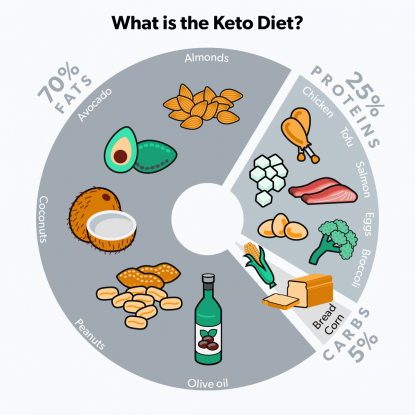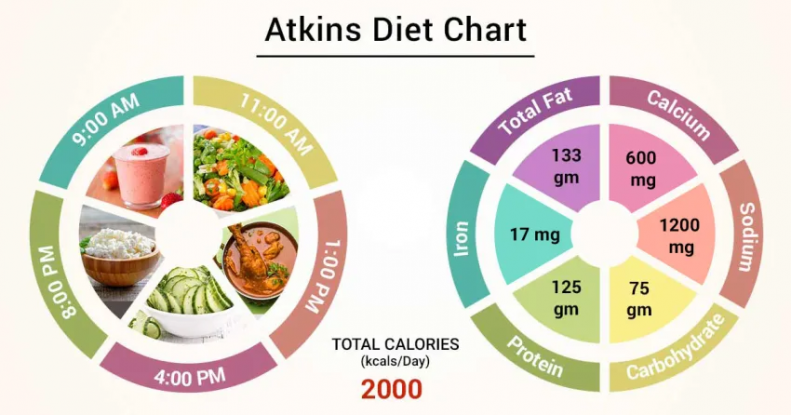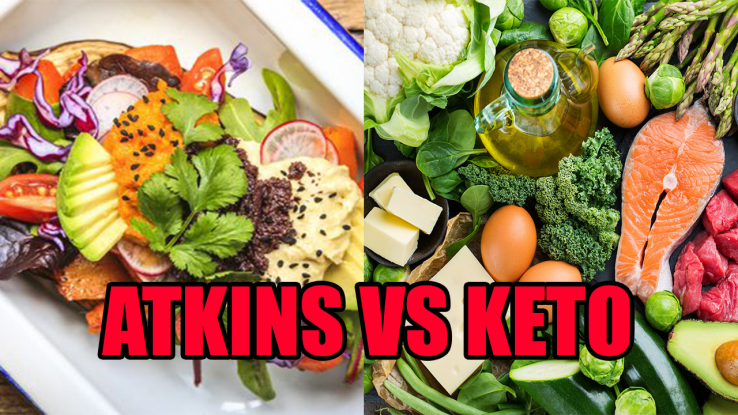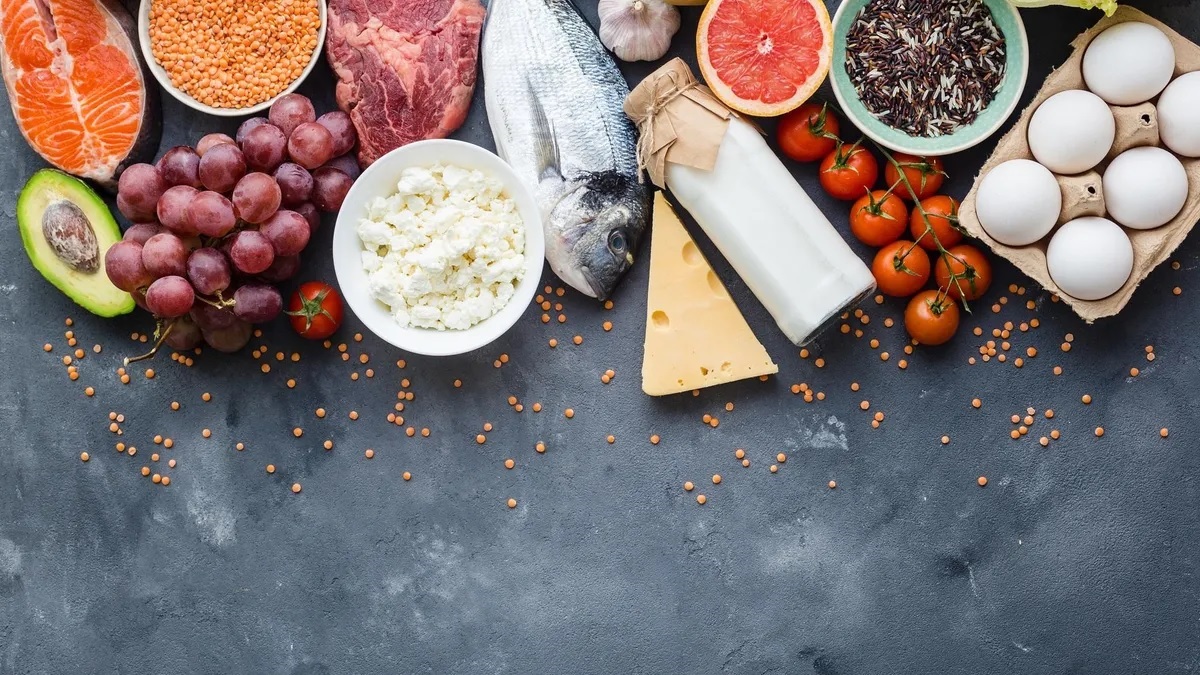“We are what we eat” a very well said phrase by Ludwig Feuerbach, a German philosopher. This notion simplifies the whole concept of staying healthy by eating right because the food one eats has a bearing on his mental as well as physical health. Life these days has become intensely robotic and people opt for the food options that are readily available and lighter on pocket meanwhile, neglecting the potential risks that unhealthy eating habits pose to one’s health. One of the major adverse effects of taking imbalanced diet is obesity that serves as a cause for many other diseases.
After many years of research, researchers have come up with the studies that advocate the long-term health hazards associated with obesity and possible ways to get rid of it. To kick start their weight loss process, people look for some easiest and quickest ways. Out of many weight loss diet options, keto diet and Atkin diet are two such low carbs diets that help reduce the weight at a faster pace in comparison to other diet plans and are liberally followed by a large population around the globe. Both these diets work on the basic principle of cutting down the carbs that are utilized by the body as the primary source of energy and introducing an increased amount of fats thus body falls short of carbs sources and starts consuming fats for the basic energy requirements.
Despite having the similarity in many ways keto and Atkins are two different ideas. This blog aims at providing all the necessary information about both the diets, their similarities and how do they differ.
Read More: What are healthy breakfast foods? Try these 5 foods. – About Pakistan
What is Keto Diet?
In early 19th century the ketogenic diet was commonly used to help control seizures, later it was introduced by Dr Russell Wilder in 1924 at the Mayo clinic as a treatment for epilepsy and became very popular during 1920s and 1930s until the anticonvulsant medications were introduced, even till now it is used as a means of therapy for those who develop resistance to anti-epileptic medications.
It is a high fat, adequate proteins and low carbohydrate diet. It is highly restrictive and a strict diet which is the one reason that it catalysis the weight loss. In this diet total carbohydrate intake is reduced to less than 50 grams and can be as low as 20 grams per day.
How Does Keto Works?
All the cells in the body function by obtaining energy from glucose, which comes from eating carbohydrate foods. Due to unavailability of carbohydrates the body switches to fats rather than carbs to provide energy. The brain demands up to 120 grams of glucose per day, because it cannot store glucose. High intake of fats puts the body in a metabolic state called ketosis. When body is deprived of glucose it first utilizes the stored glucose from liver and temporarily breaks down the muscles to obtain glucose, if this continues for 3 to 4 days, stored glucose is fully depleted, insulin levels drop in blood and body starts using fat as a primary fuel.

Ultimately liver produces ketones which are used as an energy source in the absence of glucose. Storage of these ketone bodies in blood is called ketosis. The rate of ketosis is directly proportional to the body’s fat percentage and basal metabolic rate of a person.
What Should Be Eaten In Keto Diet?
While on keto diet, an individual is required to take 70-80% fat from daily calories,10-20% proteins and 10% or less carbohydrates, on an average. The most commonly used ketogenic ratio is 4:1 and 3:1 this means to eat 4 grams of fats for every 1 gram of proteins and carbohydrates. Some of the food options to choose from in a keto diet are as under:
- Fish
- Meat and poultry
- Eggs
- Dairy and dairy alternatives including cheese, plain and Greek yogurt.
- Cream
- Unsweetened plant based milk
- Green leafy vegetables
- High fat veggies (avocados, olives)
- Nuts and seeds
- Fats and oils
- Unsweetened coffee and tea.
Read More: How to Prevent High Cholesterol level in Blood? – About Pakistan
What is Ketoacidosis?
As the liver continues to process the fats into ketones they start building up in the blood which causes it to become acidic. When the level of ketones rises in blood beyond a certain limit, the state is called ketoacidosis. This is an alarming situation which needs to be treated immediately to maintain the homeostasis of the body.
What is Atkins Diet?
Atkins diet is low carbohydrates eating pattern which was first devised by a cardiologist Dr Robert C. Atkins in 1960s. It focuses on restricting the carbohydrates and introducing fats and proteins to meet the daily caloric requirement of the body. The purpose of this diet is to help you with weight loss and keep it off by maintaining a healthy balance between carbohydrates, fats and proteins. Atkins diet is comparatively a sustainable diet to maintain weight in a healthy BMI range in a long run.

Phases of Atkins Diet:
Atkins diet is split into four different phases. Depending upon the weight loss goal a person can start from any of three initial phases.
Phase 1: Induction
In this phase you cut off all the carbs eating only about 20g of carbohydrates that too from foundation vegetables that are avocados and olives. You don’t have to limit fats and oils, but you can not have most of the fruits and foods with added sugars. You can add protein group, including foods like fish, shellfish, poultry, eggs, meat and cheese. This phase lasts for minimum of two weeks till a person moves to the second phase.
Phase 2: Balancing
Phase two starts when a person is almost 10 pounds away from the weight loss goal. In this phase 12-15g of carbs are taken per day that too from foundation vegetables and carbs are increased gradually over a few weeks. Carbs like berries and some starchy vegetables are included in diet.
Read More: What Can You Drink If You Have Diabetes? – About Pakistan
Phase 3: Pre Maintenance
Pre maintenance phase starts when the goal is reached. Carb content is gradually increased, fruits, starchy vegetables and whole grains are reintroduced into the diet. You can add 10g of carbs each week, but if the weight loss stops carbs are again reduced to a level which creates a caloric deficit to promote weight loss or maintain the weight.
Phase 4: Life Time Maintenance
Once the target is achieved the next step is to maintain the weight in a healthy range for this purpose you have to keep on with this way of eating for good.
Adverse Effects of Atkins Diet:
During the early phases of Atkins diet when carbs are cut down to an extremely low level, there are some common side effects that are experienced that includes headache, dizziness, weakness, fatigue and constipation. All these problems get resolved once carbs intake is adequate to provide energy to body, but if the symptoms persist an immediate consultation with a dietitian or a general physician is recommended.
Difference Between Atkins and Ketogenic Diet

| Atkins Diet | Ketogenic Diet |
| It was introduced as a mean to lose weight by a cardiologist | Ketogenic diet was invented to treat the children with epilepsy and was used for seizure prevention. |
| It is split into different phases and carbohydrates are increased gradually with each progressive phase. | Carbohydrates remain very low throughout the period of diet and it is mainly based on the principle of ketosis. |
| Atkins diet is sustainable for longer periods of time as compared to keto diet because as the carbs are increased body’s energy source is switched back to glucose and homeostasis is maintained eventually. | Keto diet is very restrictive and it is not a healthy option to continue for more than a certain period of time due to it’s negative effects on health specifically on liver and kidneys which are under excessive load to process the fats and remove the by-products from the body respectively. |
| Atkins diet is safer due to it’s sustainability and less restrictive nature. It has fewer side effects which can be managed by making necessary modifications in diet. | There is higher risk of developing life threatening conditions due to keto diet such as ketoacidosis which needs to be treated immediately. |
| Results are based on the phase of the atkins diet, in early phases weight loss is quicker and more prominent and the process slows down gradually as more carbs are added back in the diet. | Ketogenic diet delivers rapid results and within weeks a person can safely lose up to 20 pounds or even more depending upon the weight and BMR of an individual. |
| Protein intake has no specific measure and it can be taken by keeping in view the caloric need of the body. | Protein intake is limited to 20% of the daily caloric requirement which means that a person can fulfill 20% of it’s caloric requirement from Proteins sources. |
| Weight maintenance is comparatively easy by keeping a track of portions of major food groups including carbohydrates, Proteins and fats and a person is less likely to get those extra pounds back that are shed through atkins diet. | Weight bounces back quickly as soon as a person gets back to his normal eating habits because the body starts storing glucose at a greater pace as a reflux mechanism and there are more chances for a person to develop insulin resistance which slows down the process of weight loss. |
Similarities Between Ketogenic and Atkins Diet:
Both the diets are low carb diets relying on fats to meet the energy requirements of the body. Nevertheless, these diets are not cost effective and can’t be continued for a lifetime. They are fad diets which pose serious threats to health and are equally damaging to body’s normal coping mechanism against major nutritional deficiencies.
Read More: The Science of Weight Loss – About Pakistan
Keto or Atkins: Which Diet To Follow?
Honouring one’s health should be the first thing to be concerned about while choosing a diet plan. Anything that puts your health at stake is never a wise choice to be made. If a person is struggling with weight loss he should consult a dietitian prior to making dietary choices. Eating in moderation and doing a moderate intensity physical activity for 30 minutes for at least 5 days a week are the recommended guidelines to stay fit and healthy.
In a nutshell, weight loss is not an overnight process, it requires a person to make necessary lifestyle modifications and think beyond the notion “eat, drink and be merry” to live a healthy life.


















